Convincing myself to take a staycation wasn’t hard to do. I live in Mesa County, Colorado, which is home to nearly 1.6 million acres of public land – the highest of any county in a state rife with open spaces – and since moving here in 2019 I’ve frequently dealt with a pleasurable thorn in my side. That is, each time I head to a trailhead to hike, bike, or splitboard, I drive by another trailhead that I didn’t know existed. This is overwhelming. Mock me if you must, but I pride myself on covering a lot of ground, and when the amount of ground that needs covering seems to multiply faster than campers at an REI sale, my inability to be everywhere results in an incessant twitch in the leg. I tend to be far flung when I take time away from the computer, fully embracing the “vacate” aspect of vacation. But for once, I decided it was time to stay closer to home and attempt to catch up on what’s fresh and new in my usual zone.
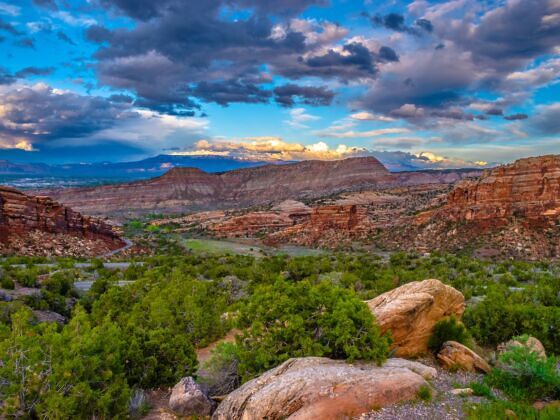

How an Outdoorsy Staycation in Grand Junction Reinvigorated My Appreciation for Where I Live
Seeing Grand Junction with new eyes
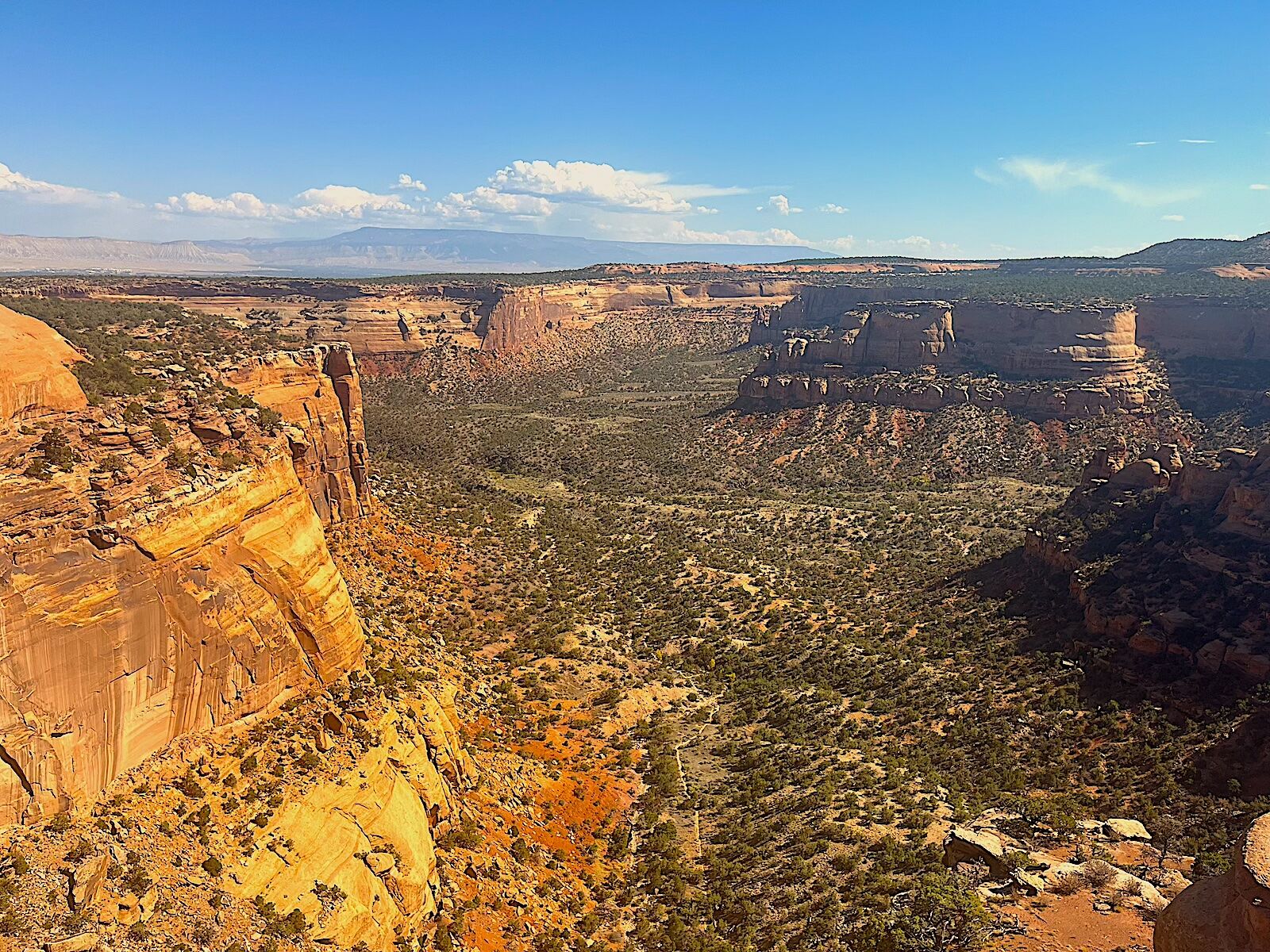
Colorado National Monument was signed into existence by President Taft in 1911 using the Antiquities Act, which grants presidents the power to declare a national monument. Hiking trails wind through the monument. Photo: Tim Wenger
To do so, I hopped the bus into downtown Grand Junction, a 70,000-strong regional hub and the largest city between Denver and Salt Lake City. Despite being the economic center for Mesa County’s 150,000+ residents, the city maintains unparalleled outdoor access, with dozens of trailheads offering hiking, mountain biking, horseback riding, and off-roading for recreators of all levels.
I checked into the Hotel Maverick, a refined property on the Colorado Mesa University campus that’s staffed largely by students in the school’s Hospitality Management program. The boutique hotel opened in 2020 in a lodging market defined by chain properties and loyalty points, offering a home base to the adventure crowd that seeks authentic vibes. My two-year-old daughter, Olivia, was immediately drawn towards the repurposed gondola car temptingly parked out front of the hotel, and we didn’t even make it inside until 20 minutes later, after her stuffies had sufficiently occupied the tramcar. Dad appreciated the seasonally rotating veggie lasagna on the menu at Devil’s Kitchen on the hotel’s top floor, where we dined on the balcony overlooking Colorado National Monument and the glistening constellation of lights covering the brand new Asteria Theater next door. Inspired by these views and the craft beer in my glass, I watched the sun set a Broncos-orange hue atop the Monument while appreciating how much this small city has refined itself right under my nose.
Case in point: The Grand Valley is an American Viticultural Area (AVA), home to more than 30 wineries. I’d never been to Two Rivers Winery west of downtown, and joined a group to visit the tasting room for happy hour. Known for its chardonnay, I also appreciated the Vintner’s Blend red. The winery also has a chateau where guests can rent rooms overnight, frequently used for weddings and special events.
Canyon bathing and monument hiking

A big horn sheep greeted us, seemingly with a smile. Photo: Tim Wenger
The next morning it was time to actually explore those trailheads I’d promised myself. The Hotel Maverick offers a new guided experience of which I took part known as “canyon bathing.” A play on the Japanese concept of forest bathing, canyon bathing – here under the moniker “Silence, Solitude, & Serenity,” requires hiking out into a desolate canyon and embracing one’s innate connection to nature.
“I’d describe canyon bathing as part hiking, part curiosity and being one with your surroundings,” our guide, a local naturalist named Zebulon Miracle, said as we walked down The Ribbon Trail toward a large sandstone rock face, a flat surface tilted slightly toward the high desert below and the city of Grand Junction beyond. We paused to reflect, sitting on the rock to calm our minds and be in the moment.
Sitting atop a sheet of sandstone overlooking the Grand Junction area, I uncovered what is now my favorite view, my favorite place to sit among both desolation and vibrant life. I’d mountain biked past this point before, but sitting, bathing, in its expanse opened up a perspective that before I’d entirely missed. I became immensely proud to live here. There are life decisions of which I now question, but moving to western Colorado is not among them.
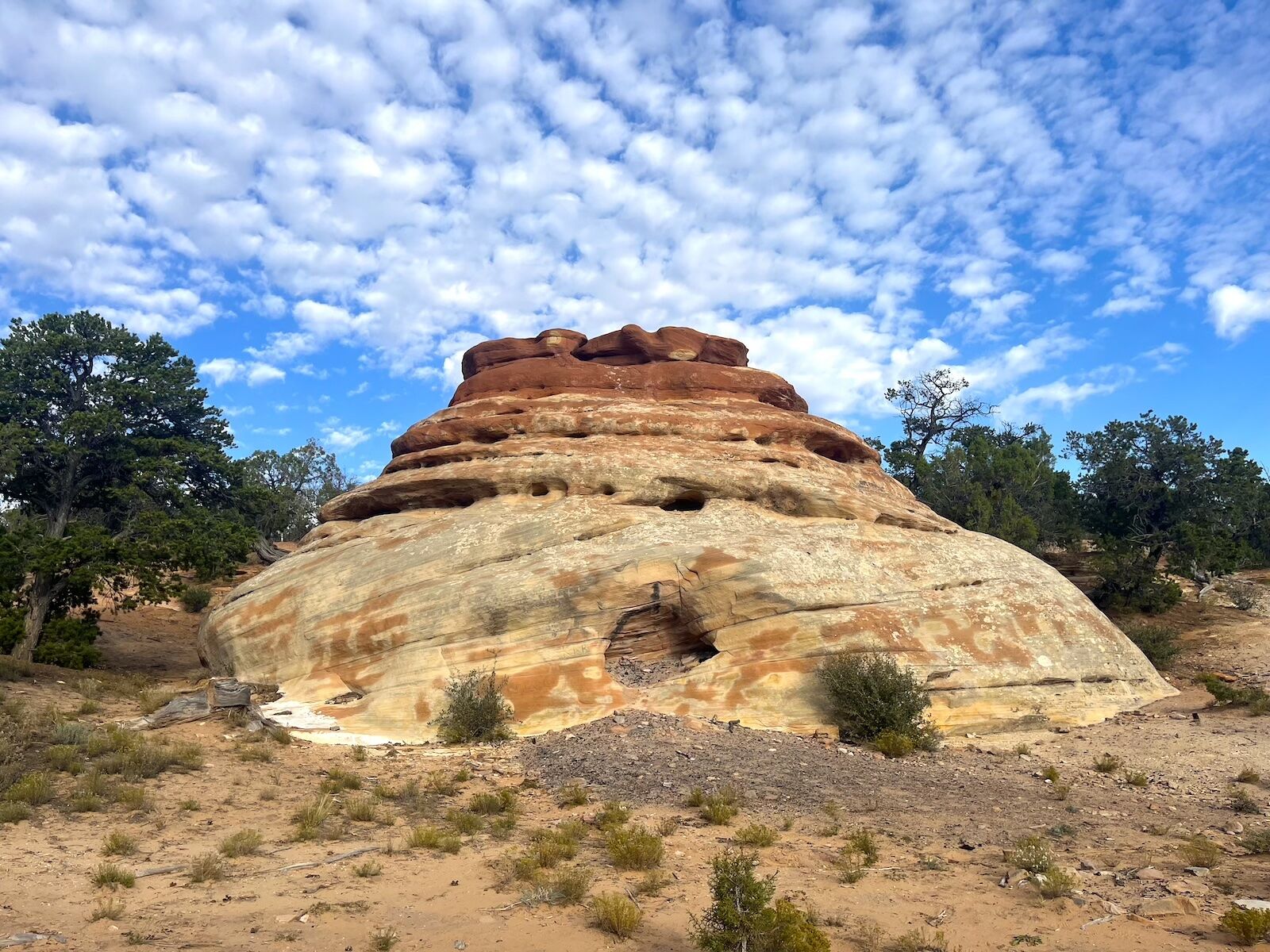
A sandstone formation along The Ribbon Trail, the carved out area in front was used by Indigenous peoples as a cookstove. Photo: Tim Wenger
Desert bathing proved a more mindful way to experience a local trail, with focus on the geology, plant life, and importance of water to the region – a great way to gain an understanding of the area’s natural history. The experience can be customized and is adaptable for those with disabilities. Miracle filled the hiking time with tidbits about our surroundings that only a naturalist could know, such as that sage – which is plentiful in this area – is slightly poisonous, which is why it’s historically been used in medicines. Indigenous cultures found it great for a stomach ache, and for Miracle, who regularly pulls a small piece and places it on his tongue while on the trail, “Sage is the taste of hiking.”
Earlier in 2024 I decided this would be the year I’d finally cover much of the hiking trails within Colorado National Monument. This protected space covers 32 square miles adjacent to the Uncompahgre Plateau’s north rim, an area first occupied and held sacred by the Ute Indian Tribe of the Uintah and Ouray Reservation, the Ute Mountain Ute Tribe, the Southern Ute Indian Tribe, the White Mesa Ute Community, and the Navajo Nation – but not appreciated by white settlers until John Otto proclaimed in the early 1900s that “I’m going to stay and promote this place, because it should be a national park.”
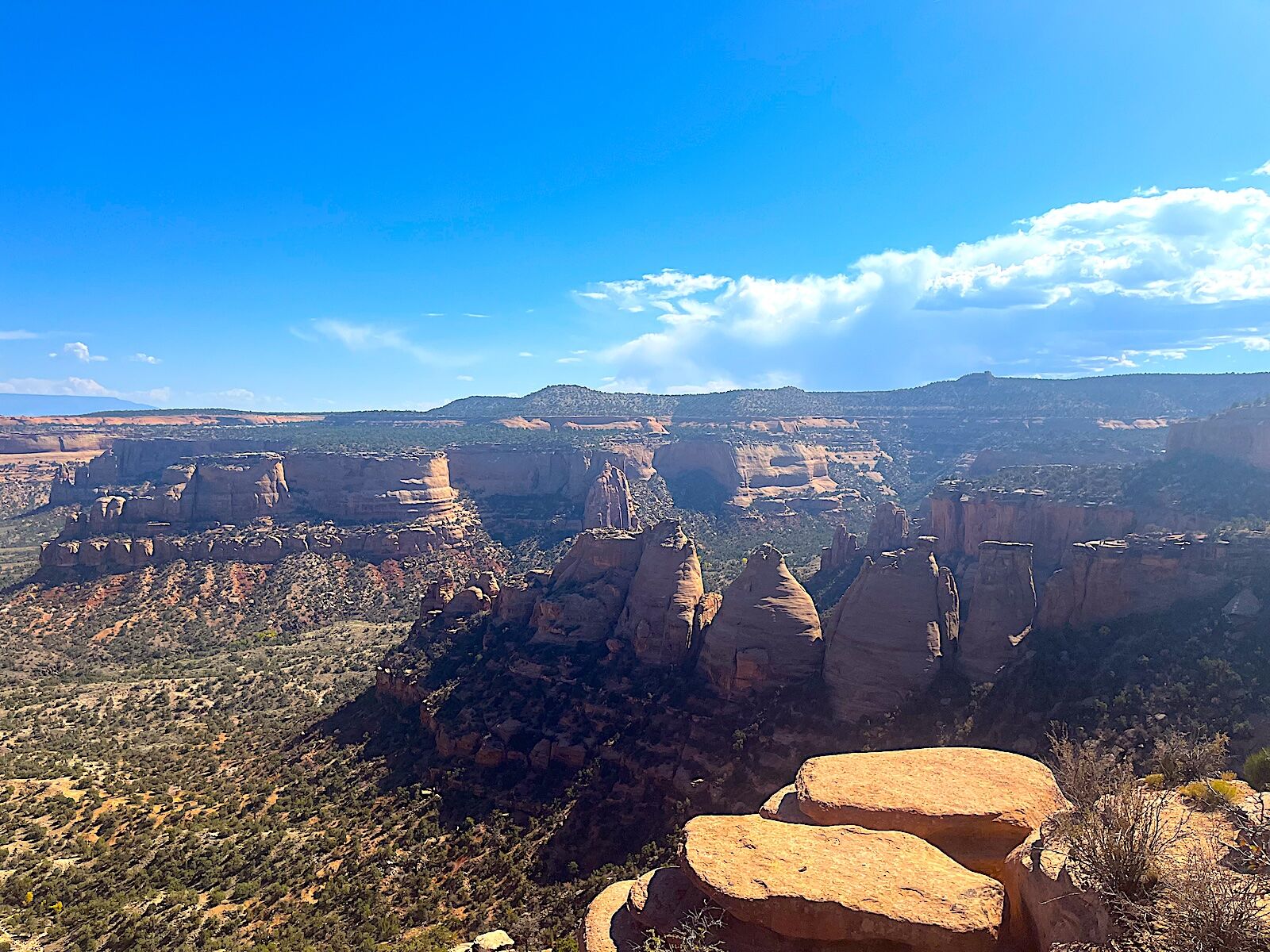
Looking out from a viewpoint at Colorado National Monument. Photo: Tim Wenger
Reddish-brown tinted sedimentary rock formations, some dating back 160 million years, form a series of U-shaped canyons that resulted from volcanic activity and millions of years of subsequent seismic activity and erosion. Newer basalt rock dots the canyons, adding a darker hue. Now, the area is lined with pinyon and juniper trees that form a picturesque and pungent layer of deep greens across the canyons, a landscape as lush and striking as the Grand Canyon and with an adjacent area, Rattlesnake Canyon, containing the second-highest concentration of natural arches anywhere in America, behind only Arches National Park. In 1911, President William Taft signed a proclamation declaring the monument under the protection of the National Park Service, and over the ensuing century a network of well-maintained hiking trails has been established both atop the monument’s high-desert canyons and down within the canyons themselves, with several access points in the Redlands area of Grand Junction.
Since March I’ve ventured to nearly every trailhead within the monument, sometimes with my daughter but often on my own. The lower trails from the Wildwood, White Rocks, and Lower Monument Canyon trailheads offer stunning views of the towering vertical rock formations within the monument such as Bottlecap and Eagle Towers, sheerwalled monoliths that phalice towards the sky like an arm stretching to the heavens

Colorado National Monument was signed into existence by President Taft in 1911 using the Antiquities Act, which grants presidents the power to declare a national monument. Hiking trails wind through the monument. Photo: Tim Wenger
On this occasion I partook in the hike from the Canyon Rim Trailhead, behind the visitor’s center, to Window Rock – a quick two-mile hike I didn’t even know existed because I’d never taken the time to actually look behind the visitor’s center. The trail wound along the canyon’s rim, a vivid overlook into the geologic evolution of our planet since the Mesozoic era. From here I looked down upon the canyons and some of the trail mileage I’d recently covered. En route to the trailhead, with a few others in tow, we encountered BigHorn Sheep that came so close to our vehicle as we inched along Rim Rock Drive atop the monument that it was as though they’d wanted to join our pack.
Venturing to land’s end
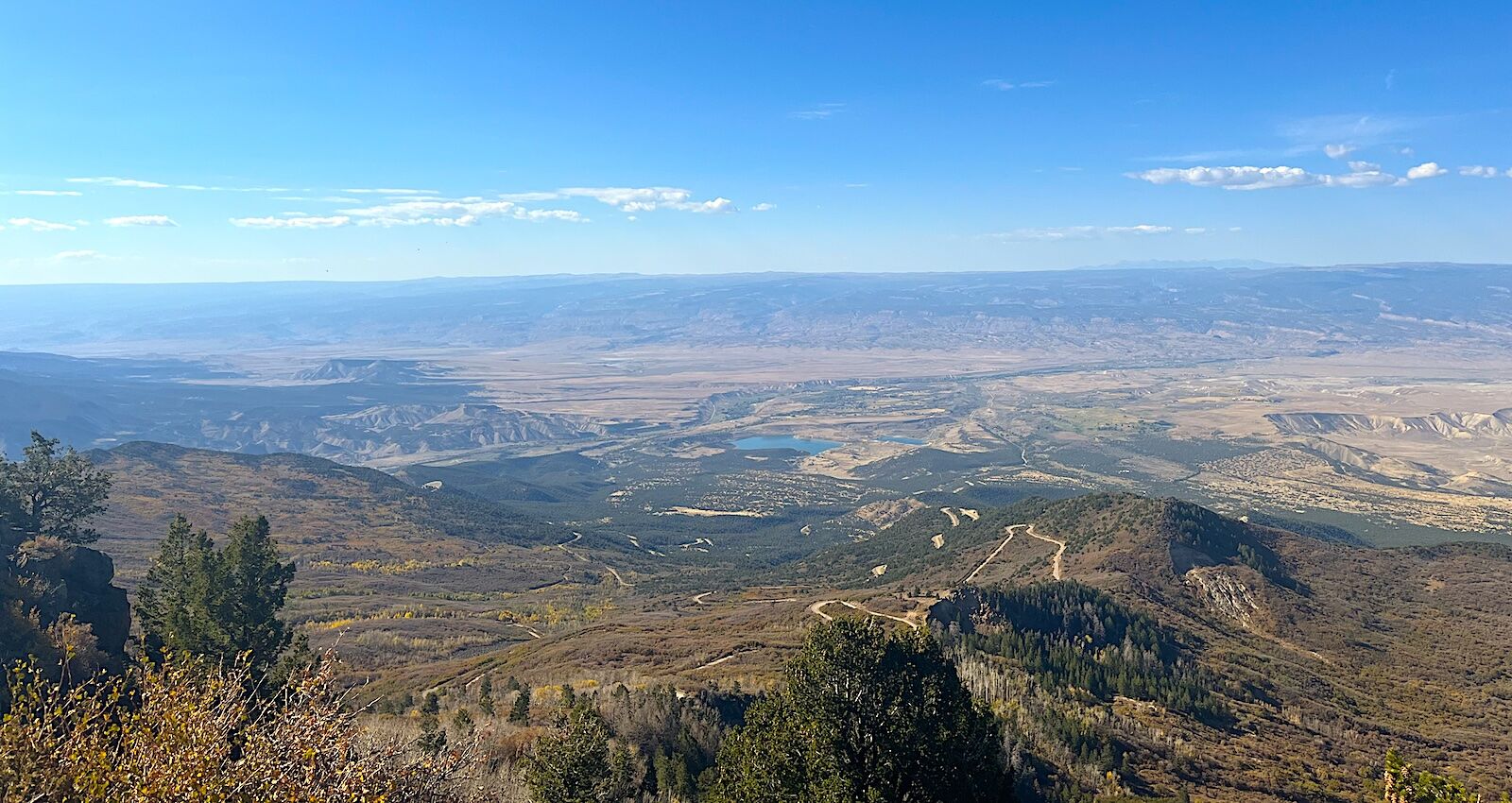
Looking out from Lands End Observatory. Lands End Road, which we traversed en route, winds its way up the Grand Mesa from the valley floor. Photo: Tim Wenger
Among the most iconic spots in Mesa County is the Lands End Observatory, atop the Grand Mesa at 10,500 feet in elevation. From a viewpoint on top of the world’s largest flat-topped mountain, we looked out over the vast array of open space that covers western Colorado. This is a truly unique landscape, where the Rockies give way to the high desert, and from nearly 11,000 feet above it’s possible to see all the way to the La Sal Mountains of Utah to the west and the Book Cliffs range directly to the north.
The Book Cliffs are a band of sandy desert mountains, the only east-to-west range in the Rockies, that run from this part of western Colorado into into easetrn Utah. They’re a harsh environment – with steep trails baking in the desert sun and an ecosystem that sees an average of 11 inches of precipitation per year. Plant and animal life here must be resilient, but few areas of the United States better highlight the beauty of the high desert.
Horseback riding has never been a regular activity of mine, but among the most frequent points of discussion in local press and among those who visit the Grand Junction area is the presence of wild horses in the Little Book Cliffs Wild Horse Area. After descending from the Grand Mesa we joined JR’s Carriage for a ride on horseback out into the area, where we spotted several wild horses drinking from a small stream running from a nearby spring. I’d never been out on this trail, which departed north from the Coal Canyon Trailhead in Cameo. It provided views of the back side Mt. Garfield, the iconic 6,675’ postcard-worthy peak that is the area’s most well-known natural feature.

Riding through Little Book Cliffs Wild Horse Area, the Grand Mesa in the background. Photo: Tim Wenger
One of the joys of a staycation is that you uncover tough-to-find or newer spots, often my own fault as I live in an area that has been through many boom-and-bust economic cycles and is only recently finding its contemporary footing as a wine country hub that doubles as an outdoor recreation business incubator. In this case I had lunch at Cruise Control Kitchen and Cellar, a wine bar in downtown Grand Junction with a Chicago-influenced food menu. Over a Jackalope sandwich – rabbit and antelope spicy sausage named for the local professional baseball team – I was again reminded of how a city evolves as it grows. The restaurant was founded by co-owners of Sauvage Spectrum, an area winery that has driven the wine region towards a young, hip demographic. I felt this again the next morning at Cafe Sol, a breakfast and lunch spot that I frequent but had never before stopped to think about how great it is to have. I’d successfully pulled back a protective layer that had kept me from seeing everything great about where I live.
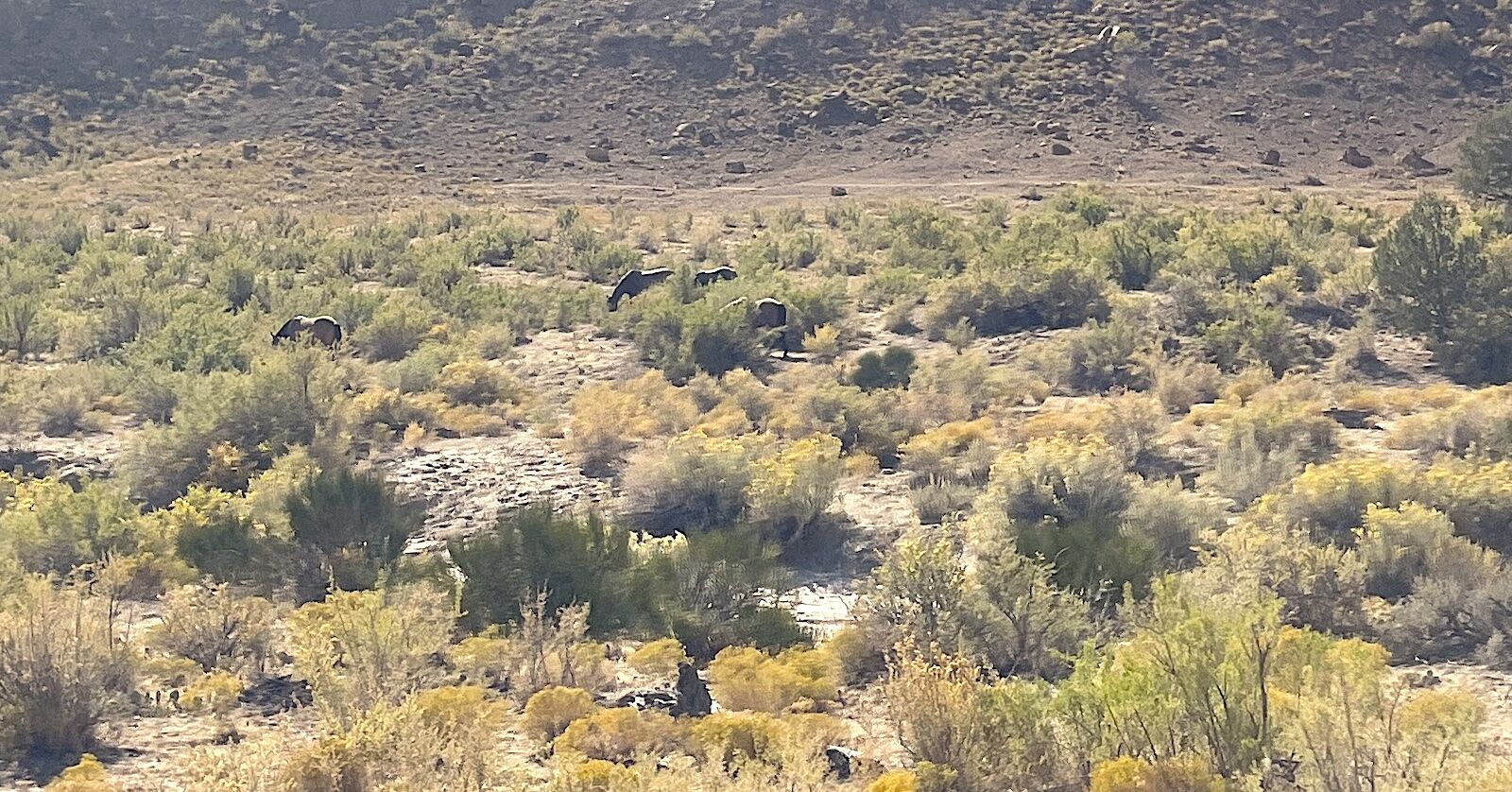
Several wild horses drink from a stream. Photo: Tim Wenger
As a travel editor, I’m constantly bombarded with reasons why I should pack up and head somewhere new. My biggest takeaway from this Grand Junction staycation is that it’s equally important to embrace where I live and remind myself why I set roots here in the first place.
As Zebulon Miracle told me as we hiked through those canyons, “Water dictates where people go, but geology dictates what they do when they get there.” Even after five years of exploring the canyons, mesas, and mountains of the region, I still have a lot to do.